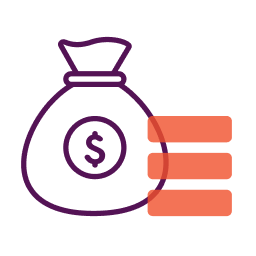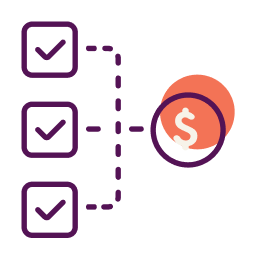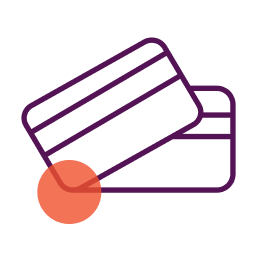While there’s more than one way to evaluate the financial health of your business, few are as closely related to success or failure as negative cash flow. Cash flow is the net amount of cash that flows in and out of your business. Cash flow management is essential for long-term growth. But how do you go about it?
The most obvious ways to solve cash flow problems is to increase sales and decrease expenses. Within those two main approaches, though, there are numerous strategies worth considering. Here are 24 to consider.
Improve your business’s financial health profile to unlock better financing options — only at Nav.
The only platform that learns what your business needs and helps you become better qualified for it.
Cash Flow vs. Profit
“Cash flow” and “profit” are two terms that are often used to describe the financial health of a business. They are also often confused with each other, but understanding cash flow vs. profit is essential to understanding the financial health of your business.
Profit
Profit is the surplus after operating expenses are deducted from total revenues. In other words, it’s what’s left over from your sales after you’ve paid for everything — cost of goods sold (COGS), salaries, rent, utilities, taxes, interest, and any other operating expenses.
Profit is typically measured over a specific period of time, like a month, a quarter, or a year. If a business makes more money than it spends, it is said to be profitable. However, being profitable doesn’t necessarily mean the business has a positive cash flow.
Cash flow
Cash flow refers to the net amount of cash and cash equivalents being transferred into and out of a business at any given point in time. It will change as money comes in or goes out of the business.
It represents how much cash the business generates (cash inflows from activities like selling goods and services, receiving interest and dividends, and obtaining loans or investments) versus how much it spends (cash outflows for expenses like purchasing inventory, paying salaries, and repaying loans).
How To Calculate Cash Flow
There are several ways to calculate cash flow, and each can be helpful in different situations.
- Operating cash flow: Cash flow generated from normal business operations.
- Investing cash flow: Cash flow generated from business investments such as the sale of securities or physical assets.
- Financing cash flow: Cash flow generated from activities used to fund the company including debt, equity, and/or dividends.
The best way to understand your business cash flow is to review the financial statement called Statement of Cash Flows. If you use accounting software, and you (or your bookkeeper) keep your accounting up to date, this financial statement should be easy to generate. Your accounting professional can also help you create and understand cash flow statements.
How to Increase Cash Flow (Even During High Inflation Periods)
Operational Expenses
Bringing in income is an important part of the cash flow equation, but the money that flows out can quickly and unapologetically leave you in the red. To close out the year, do some 2018 recon to make sure that your operating expenses are in check. Consider improving your inventory management to cut operational costs as well.
1. Negotiate Better Terms With Vendors & Suppliers
Product inventory and operational goods and services provided by suppliers and vendors are essential line items, and if you’re just adding them up at the end of the month without question or exploration, you may be spending more than you have to.
Do you have a healthy, long-term relationship with your vendors and suppliers? Consider working with them to renegotiate prices, credit terms, and/or secure discounts for bulk orders, both of which can cut costs.
2. Reevaluate Spending
Are you paying for a lot of goods or services that you simply don’t need? Can you cut some of the line items out of your monthly budget? Over time, small yet unnecessary expenses add up. You need to reevaluate your cash flow strategy.
Though it’s easy to forget about or overlook trivial expenses., they can often leave you paying hundreds of dollars, if not more, in unnecessary bills and fees over a year. It’s always a good idea to work to improve your cash-flow management. Take a hard look at your bills and determine where you can make cuts, even if it’s momentarily.
3. Become More Efficient
Realistically, the notion of “efficiency” in your business is worthy of its own post, if not a series, but in the case of cash flow efforts, it’s essential to mention. Efficiency can mean everything from how you use utilities to how you schedule your workforce.
The new year is a good time to look at ways you may be able to cut back without harming sales and revenue. Small things, like using smart technology to control heating or cooling efforts, using more efficient equipment, turning to automated business software, or reorganizing workstations can make your business operate more efficiently and therefore cost you less in utilities, inventory, and wages.
Getting Paid
4. Collect Payment Upfront
The faster your business gets paid, the more cash your business will have to pay expenses, invest in growth, or even to park in a savings account for future needs. Consider charging up front, or at least collecting a deposit.
Tip: If you provide anything of value to customers before they pay, you’re a lender. Check the business credit scores of your customers before you sell them products or provide services without getting paid in full.
5. Invoice Early and Often
When your plate is full, as it often is, it’s easy to call behind on administrative tasks. Don’t let invoicing be one of them. Send invoices on time every month and keep due dates consistent. Doing so will set clear expectations about the financial arrangement between you and your customers, and can help you meet your financial goals. Follow up on invoices that aren’t paid on time.
6. Make It Easy To Pay
Give your customers options that make it easy to pay. Sign up with a credit card processing company so you can accept credit cards and debit cards. B2B customers may prefer to pay via ACH, while other customers may prefer payment options like Venmo, Paypal, or Cash App.
7. Offer Discounts for Early Payments
Consider encouraging B2B customers to pay early by offering a discount. For example, a business that offers 2/10 net 30 terms offers thirty days to pay but gives a 2% discount if the invoice is paid in ten days. When you offer discounts, make sure clients are aware of them.
8. Charge for Late Payments
A penalty or late fees for late payments for a certain number of days late can help customers or clients prioritize your bill in an effort to avoid unnecessary fees. In extreme cases, you can even set a system for collections. Consider debt collection services to get past due invoices paid.
If you decide to introduce a charge for late payments, make sure you give your customers adequate notice in writing.
9. Factor Your Invoices
If you still have problems collecting, you may want to consider invoice factoring, which is when you sell your unpaid invoices to an invoice financing company in exchange for a certain percentage of the value (80-85%) up front. Once the company collects on the invoices, they will give you the remaining about minus fees.
This type of financing is meant for short-term needs, and the cost may be higher than other financing options. But it can free up cash that’s locked up in accounts receivable when you’re in a cash crunch.
Invest In Marketing & Sales
Maybe the problem isn’t getting paid but how much you get paid or how many customers you have. A review and upgrade of your pricing policy and marketing efforts can help increase cash flow and market share.
10. Raise Your Prices
If you’re getting paid on time, or if your business cash flow doesn’t depend on invoicing, then stagnant or decreasing revenue may be due to outdated or inefficient pricing. Have you been undercharging and dipping into your contribution margins?
There are a number of reasons that your pricing may be inefficient, but before you jump into a pricing overhaul, take the time to review all factors and how they’ve changed over the last month, quarter, or year. As part of your evaluation it’s essential to account for payroll; equipment, vendor, and supplier fees; and competitor prices.
11. Sell More Products or Services
Are you relying heavily on email marketing but not really seeing the fruit / profit of your efforts? Have you let your social media accounts get a bit dusty? Do promotions and sales that once sent your bottom line rocketing into the green now barely cause a blip?
Sometimes marketing efforts can become stale and predictable, leaving your customers uninspired or going elsewhere with their business. Take inventory of your existing marketing efforts and determine where you may be able to make changes to amp up your existing and engage new customers.
12. Identify & Target New Markets
In some cases, this may be as simple as some thoughtful and creative brainstorming that results in new ways you can market your product or service to other consumers based on their needs (e.g., problem/solution marketing). In others, you may need to do some significant consumer research and examine the efforts of your competitors or potential competitors.
One great way to identify new markets is to actively engage the correct social media accounts.
Doing so can put your brand and products in front of more and more potential clients or customers and engaging with those customers can help you determine new and existing ways to market your product or service.
13. Sell Online
If you’re a brick and mortar company with a thin online presence, and if it’s economically and logistically reasonable to sell your product online, you may want to consider reaching a new audience through e-commerce. There are a variety of easy-to-use platforms, like Etsy and Shopify, that may be able to accommodate your needs.
14. Reduce Inventory Levels
By reducing inventory, small business owners can free up cash for other purposes. It can also help the business save money on storage and handling fees. However, selling inventory at a deep discount can also negatively impact profitability so it’s important to carefully consider when to discount prices to increase sales.
15. Streamline Business Processes
Efficient and streamlined business processes can reduce costs, increase productivity, improve customer satisfaction, and ultimately, boost cash inflow. Streamlined processes also reduce waste, which saves money.
16. Get Organized
Entrepreneurs often wear a lot of hats and it’s easy for essential tasks to slip through the cracks, leading to cash flow issues. Getting organized in key areas, including finances and operations can help your business boost revenues and cut expenses, leading to improved cash flow.
17. Improve Customer Service
Excellent customer service can increase customer loyalty and repeat sales, ultimately bringing in more revenue. Poor customer service increases churn rates and increases customer acquisition costs.
Organize Your Finances
18. Use Invoicing & Accounting Software
Invoicing and accounting software can make it easy to invoice quickly and on time. Zoho, FreshBooks, and QuickBooks are just a few of the available options and can offer you instant access to your financial information no matter where you are.
Compare Accounting Solutions
An accounting software or service can help you avoid costly mistakes and get a clear picture of your overall finances. Use Nav to find the right accounting solution for your business.
19. Forecast Your Cash Flow
A cash flow forecast is essential for multiple reasons. It will help the business owner identify cash flow shortfalls before they become major problems. It can help the business make decisions about key purchases or investments, and to play for growth.
20. Set Financial Goals
Setting financial goals is a big part of how a business gets where it wants to go. Your business plan will help you figure out what those goals are, the milestones you need to reach, and how you plan to achieve them. If you don’t have clear goals for your business, this should be at the top of your to do list.
21. Use Credit Cards for Business Expenses
Using business credit cards to pay providers and make business purchases gives you more time to pay. If you can use that time to increase sales, you’ll pay for those purchases out of cash flow. Even new entrepreneurs can qualify as long as they meet credit score requirements and have sufficient income from all sources. (Most cards don’t require minimum amounts of business revenue. Try to avoid carrying balances, though; interest rates can be high. Consider a credit card with a 0% intro APR for purchases that can be financed over time.
100+ Business Credit Cards in One Click
Business credit cards can help you when your business needs access to cash right away. Browse your top business credit card options and apply in minutes.
22. Get a Line of Credit
A business line of credit is a popular short-term financing option for working capital needs. Once you’re approved, you can tap it as needed. Payment terms vary widely. Banks may require monthly payments while some online lenders may require weekly payments. A line of credit is one several types of small business loans many entrepreneurs line up. Ideally you want to get approved before you need it so you have time to shop around for the best option.
23. Get Help From a Financial Advisor
You can’t be an expert in everything, so don’t be afraid to get some help with these key areas of your business. Options include:
- Accounting professional
- Business coach
- Business turnaround specialist
- Business mentor (free from SBA resource partners like SCORE and SBDCs)
24. Use a Cash Flow Tool
Cash flow management shouldn’t be manual anymore. Nav’s Cash Flow Tool is free for any Nav customer to use. You can connect an unlimited number of bank accounts to the Cash Flow Tool to stop skipping between tabs. Instead, you’ll see the big picture in one place. Also, you can set up real-time alerts and see funding solutions tailored to your business’s needs.
How Nav Can Help
Join millions of small business owners using Nav to improve their business financial health. The Cash Flow Tool allows you to link and manage all your bank accounts in one place. Get a clear picture of your borrowing power to access the funding options you need to run your business.
Get the credit your business deserves
Join 250,000+ small business owners who built business credit history with Nav Prime — without the big bank barriers.
FAQs
How can an entrepreneur increase cash flow in a business?
Entrepreneurs can increase cash flow by optimizing invoicing processes, encouraging prompt customer payments, and negotiating favorable terms with suppliers. Efficient inventory management and cost control measures also contribute to improved cash flow and overall business liquidity.
How can a business improve its cash flow forecast?
To get better cash flow forecasts, businesses should regularly update financial projections based on current and anticipated revenue and expenses. Utilizing advanced financial modeling tools and closely monitoring key performance indicators (KPIs) can provide more accurate and real-time insights, helping refine cash flow predictions.
What drives cash flow in a business?
Cash flow in a business is primarily driven by the efficient management of sales and expenses, ensuring timely collections from customers and optimized payment terms with suppliers. Additionally, factors like effective inventory management, cost control, and strategic investment decisions play key roles in influencing overall cash flow.
How can a small business manage its cash flow?
A small business can manage its cash flow by closely monitoring and forecasting income and expenses, implementing efficient invoicing and payment collection processes, and maintaining a cash reserve for unexpected expenses or downturns. Additionally, negotiating favorable terms with suppliers and keeping a lean inventory can contribute to a healthier and more stable cash flow.
This article was originally written on February 3, 2020 and updated on December 5, 2023.
Rate This Article
This article currently has 21 ratings with an average of 4.5 stars.




Have at it! We'd love to hear from you and encourage a lively discussion among our users. Please help us keep our site clean and protect yourself. Refrain from posting overtly promotional content, and avoid disclosing personal information such as bank account or phone numbers.
Reviews Disclosure: The responses below are not provided or commissioned by the credit card, financing and service companies that appear on this site. Responses have not been reviewed, approved or otherwise endorsed by the credit card, financing and service companies and it is not their responsibility to ensure all posts and/or questions are answered.